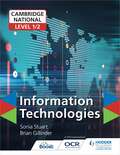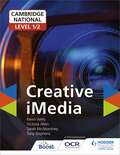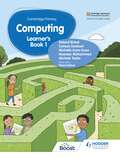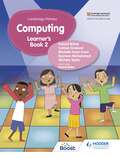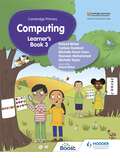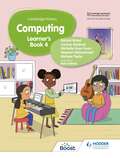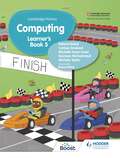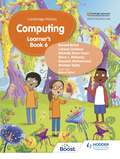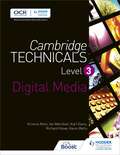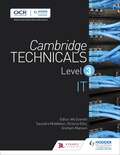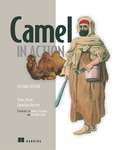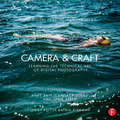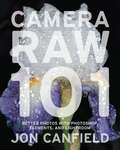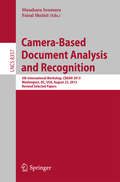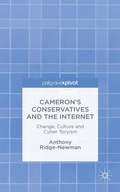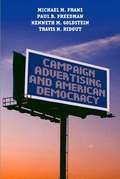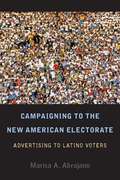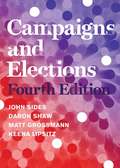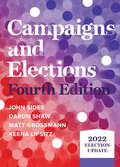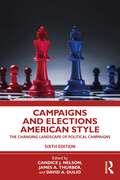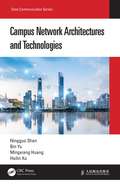- Table View
- List View
Cambridge National Level 1/2 Certificate in Information Technologies
by Sonia Stuart Brian GillinderTarget success in the Cambridge National Certificate in Information Technologies with this essential classroom resource that will develop students' understanding of data, build their transferable skills and knowledge to become confident users of technology and help them prepare for the external assessment. Builds students' knowledge through clearly focused content and activities to assess understanding and aid progression Prepares your students for the examined assessment with opportunities to test and consolidate understanding Provides students with contexts to apply digital technology skills
Cambridge National Level 1/2 Creative iMedia
by Victoria Allen Kevin Wells Sarah McAtominey Tony StephensStrengthen learners' grasp of the most challenging units and develop the skills required for success with this student book mapped to the Cambridge National Level 1 / 2 in Creative iMedia. Covering the mandatory and optional units, this textbook will help to build knowledge, reinforce classroom learning and test the students' understanding.· Builds students' knowledge with clearly-focused content to aid progression and activities to assess understanding.· Prepares your students for both internal and external assessment with opportunities to test and consolidate understanding.· Support your students' progress through the course with the only textbook published for the Cambridge National Level 1 /2 in Creative iMedia.
Cambridge National Level 1/2 Creative iMedia
by Victoria Allen Kevin Wells Sarah McAtominey Tony StephensStrengthen learners' grasp of the most challenging units and develop the skills required for success with this student book mapped to the Cambridge National Level 1 / 2 in Creative iMedia. Covering the mandatory and optional units, this textbook will help to build knowledge, reinforce classroom learning and test the students' understanding.· Builds students' knowledge with clearly-focused content to aid progression and activities to assess understanding.· Prepares your students for both internal and external assessment with opportunities to test and consolidate understanding.· Support your students' progress through the course with the only textbook published for the Cambridge National Level 1 /2 in Creative iMedia.
Cambridge Primary Computing Learner's Book Stage 1
by Michele Taylor Roland Birbal Nazreen Mohammed Michelle Koon Koon Carissa GookoolThis title has been endorsed by Cambridge Assessment International Education. Help learners develop essential computing skills with an approach that uses real-life examples, reinforces key vocabulary and provides opportunities to learn, practise and apply throughout.- Encourage learners to become confident in working with information and ideas of their own and those of others with discussion tasks, as well as with What can you do? panels at the end of each unit for self-assessment.- Provide a clear pathway through the learning objectives with Practise tasks in each unit, as well as Go further and Challenge yourself! panels with questions designed to support differentiation.- Recap and activate learners' prior knowledge with Do you remember? activities and introduce new computing skills with Learn and Practise tasks.ContentsHow to use this book Term 1Unit 1 Computers are everywhere Unit 2 Be an animator Unit 3 Be a data detectiveTerm 2Unit 4 Be a designer Unit 5 We can network Unit 6 Be a problem solver Unit 7 Computers control thingsTerm 3Unit 8 Be a data collectorUnit 9 Be a games developerUnit 10 We are connectedUnit 11 Be an artist Glossary
Cambridge Primary Computing Learner's Book Stage 2
by Michele Taylor Roland Birbal Nazreen Mohammed Michelle Koon Koon Carissa GookoolThis title has been endorsed by Cambridge Assessment International Education.Help learners develop essential computing skills with an approach that uses real-life examples, reinforces key vocabulary and provides opportunities to learn, practise and apply throughout.- Encourage learners to become confident in working with information and ideas of their own and those of others with discussion tasks, as well as with What can you do? panels at the end of each unit for self-assessment.- Provide a clear pathway through the learning objectives with Practise tasks in each unit, as well as Go further and Challenge yourself! panels with questions designed to support differentiation.- Recap and activate learners' prior knowledge with Do you remember? activities and introduce new computing skills with Learn and Practise tasks.ContentsHow to use this book Term 1Unit 1 Be a game developer Unit 2 Be a data analyst Unit 3 Computers and their functionsTerm 2Unit 4 Be an animatorUnit 5 Devices and networks Unit 6 Be a designer Unit 7 Be a data scientistTerm 3Unit 8 Be an artistUnit 9 Connected and sharing Unit 10 Be a storyteller Unit 11 Computers and robots Glossary
Cambridge Primary Computing Learner's Book Stage 3
by Michele Taylor Roland Birbal Nazreen Mohammed Michelle Koon Koon Carissa GookoolThis title has been endorsed by Cambridge Assessment International Education.Help learners develop essential computing skills with an approach that uses real-life examples, reinforces key vocabulary and provides opportunities to learn, practise and apply throughout.- Encourage learners to become confident in working with information and ideas of their own and those of others with discussion tasks, as well as with What can you do? panels at the end of each unit for self-assessment.- Provide a clear pathway through the learning objectives with Practise tasks in each unit, as well as Go further and Challenge yourself! panels with questions designed to support differentiation.- Recap and activate learners' prior knowledge with Do you remember? activities and introduce new computing skills with Learn and Practise tasks.ContentsHow to use this bookTerm 1Unit 1 Making programs clearUnit 2: Hardware and software work togetherUnit 3: Be a data expertUnit 4: Be a designerTerm 2Unit 5: Networks are everywhereUnit 6: Be a storytellerUnit 7: Computers and robotsUnit 8: Be a musicianTerm 3Unit 9: Sending secret messagesUnit 10: Be a game developerUnit 11: Be a data designerUnit 12: Be an artistGlossary
Cambridge Primary Computing Learner's Book Stage 4
by Michele Taylor Roland Birbal Nazreen Mohammed Michelle Koon Koon Carissa GookoolWe are working with Cambridge International to gain endorsement for this forthcoming series.Help learners develop essential computing skills with an approach that uses real-life examples, reinforces key vocabulary and provides opportunities to learn, practise and apply throughout.- Encourage learners to become confident in working with information and ideas of their own and those of others with discussion tasks, as well as with What can you do? panels at the end of each unit for self-assessment.- Provide a clear pathway through the learning objectives with Practise tasks in each unit, as well as Go further and Challenge yourself! panels with questions designed to support differentiation.- Recap and activate learners' prior knowledge with Do you remember? activities and introduce new computing skills with Learn and Practise tasks.ContentsHow to use this bookTerm 1Unit 1 Scratch: Be a loop heroUnit 2 Google forms: Be a data controllerUnit 3 Be a speed surferUnit 4 Be a storytellerTerm 2Unit 5 Robots can workUnit 6 Be a musicianUnit 7 Be a data bossUnit 8 Be an innovatorTerm 3Unit 9 Be a code crackerUnit 10 Be a game developerUnit 11 Robots in control Unit 12 Be an artistGlossary
Cambridge Primary Computing Learner's Book Stage 5
by Michele Taylor Roland Birbal Nazreen Mohammed Michelle Koon Koon Carissa Gookool Shiva MaharajThis title has been endorsed by Cambridge Assessment International Education.Help learners develop essential computing skills with an approach that uses real-life examples, reinforces key vocabulary and provides opportunities to learn, practise and apply throughout.- Encourage learners to become confident in working with information and ideas of their own and those of others with discussion tasks, as well as with What can you do? panels at the end of each unit for self-assessment.- Provide a clear pathway through the learning objectives with Practise tasks in each unit, as well as Go further and Challenge yourself! panels with questions designed to support differentiation.- Recap and activate learners' prior knowledge with Do you remember? activities and introduce new computing skills with Learn and Practise tasks.ContentsHow to use this bookTerm 1Unit 1 Scratch MIT: Be a designerUnit 2 Be a data storytellerUnit 3 Computer storageUnit 4 Scratch MIT: Be a storytellerTerm 2Unit 5 Network devices and websitesUnit 6 Scratch MIT: Be an animatorUnit 7 Be a data engineerUnit 8 Micro:Bit Makecode: Be an innovatorTerm 3Unit 9 Cellular networks and data packetsUnit 10 Scratch MIT: Be a game developerUnit 11 Artificial intelligence Unit 12 iRobot Level 2: Be a problem solverGlossary
Cambridge Primary Computing Learner's Book Stage 6
by Michele Taylor Roland Birbal Nazreen Mohammed Michelle Koon Koon Carissa Gookool Shiva MaharajThis title has been endorsed by Cambridge Assessment International Education.Help learners develop essential computing skills with an approach that uses real-life examples, reinforces key vocabulary and provides opportunities to learn, practise and apply throughout.- Encourage learners to become confident in working with information and ideas of their own and those of others with discussion tasks, as well as with What can you do? panels at the end of each unit for self-assessment.- Provide a clear pathway through the learning objectives with Practise tasks in each unit, as well as Go further and Challenge yourself! panels with questions designed to support differentiation.- Recap and activate learners' prior knowledge with Do you remember? activities and introduce new computing skills with Learn and Practise tasks.ContentsHow to use this bookTerm 1Unit 1 Flowcharts in programming (Scratch MIT: Be a designer)Unit 2 Be a data managerUnit 3 Selecting hardware and softwareUnit 4 Variables in programming (Scratch MIT: Be a storyteller)Term 2Unit 5 Digital contentUnit 6 Sub-routines in Programming (Scratch MIT: Be an animator)Unit 7 Be a data architectUnit 8 Micro:Bit Makecode: Be an innovatorTerm 3Unit 9 Keeping data safeUnit 10 Scratch MIT: Be a game developerUnit 11 Storage and robots Unit 12 iRobot: Be a problem solverGlossary
Cambridge Technicals Level 3 Digital Media
by Ian Marshall Karl Davis Richard Howe Victoria Allen Kevin WellsExam Board: CambridgeLevel: KS4Subject: Digital MediaFirst Teaching: September 2016First Exam: June 2018Support your teaching of the new Cambridge Technicals 2016 suite with Cambridge Technical Level 3 Digital Media, developed in partnership between OCR and Hodder Education; this textbook covers each specialist pathway and ensures your ability to deliver a flexible course that is both vocationally focused and academically thorough.Cambridge Technical Level 3 Digital Media is matched exactly to the new specification and follows specialist pathways in digital content for interactive media, and moving image and audio production.- Ensures effective teaching of each specialist pathway offered within the qualification.- Focuses learning on the skills, knowledge and understanding demanded from employers and universities.- Provides ideas and exercises for the application of practical skills and knowledge.- Developed in partnership between Hodder Education and OCR, guaranteeing quality resources which match the specification perfectlyHodder Education have worked with OCR to make updates to our Cambridge Technicals textbooks to bring them more closely in line with the model assignment course requirements. We would like to let you know about a recent change to this textbook, updated pages which are now available free of charge as a PDF when you click on the 'Amended Pages' link on the left of this webpage.
Cambridge Technicals Level 3 Digital Media
by Karl Davis Richard Howe Victoria AllenSupport your teaching of the new Cambridge Technicals 2016 suite with Cambridge Technical Level 3 Digital Media, developed in partnership between OCR and Hodder Education; this textbook covers each specialist pathway and ensures your ability to deliver a flexible course that is both vocationally focused and academically thorough.Cambridge Technical Level 3 Digital Media is matched exactly to the new specification and follows specialist pathways in digital content for interactive media, and moving image and audio production.- Ensures effective teaching of each specialist pathway offered within the qualification.- Focuses learning on the skills, knowledge and understanding demanded from employers and universities.- Provides ideas and exercises for the application of practical skills and knowledge.- Developed in partnership between Hodder Education and OCR, guaranteeing quality resources which match the specification perfectly
Cambridge Technicals Level 3 IT
by Victoria Ellis Graham Manson Saundra MiddletonExam Board: CambridgeLevel: KS4Subject: ITFirst Teaching: September 2016First Exam: June 207Support your teaching of the new Cambridge Technicals 2016 suite with Cambridge Technical Level 3 IT, developed in partnership between OCR and Hodder Education; this textbook covers each specialist pathway and ensures your ability to deliver a flexible course that is both vocationally focused and academically thorough.Cambridge Technical Level 3 IT is matched exactly to the new specification and follows specialist pathways in IT Infrastructure Technician, Emerging Digital Technology Practitioner, Application Developer, and Data Analyst.- Ensures effective teaching of each specialist pathway offered within the qualification.- Focuses learning on the skills, knowledge and understanding demanded from employers and universities.- Provides ideas and exercises for the application of practical skills and knowledge.- Developed in partnership between Hodder Education and OCR, guaranteeing quality resources which match the specification perfectly
Cambridge Technicals Level 3 IT
by Victoria Ellis Graham Manson Saundra MiddletonExam Board: CambridgeLevel: Key Stage 4Subject: ITFirst Teaching: September 2016First Exam: June 207Support your teaching of the new Cambridge Technicals 2016 suite with Cambridge Technical Level 3 IT, developed in partnership between OCR and Hodder Education; this textbook covers each specialist pathway and ensures your ability to deliver a flexible course that is both vocationally focused and academically thorough.Cambridge Technical Level 3 IT is matched exactly to the new specification and follows specialist pathways in IT Infrastructure Technician, Emerging Digital Technology Practitioner, Application Developer, and Data Analyst.- Ensures effective teaching of each specialist pathway offered within the qualification.- Focuses learning on the skills, knowledge and understanding demanded from employers and universities.- Provides ideas and exercises for the application of practical skills and knowledge.- Developed in partnership between Hodder Education and OCR, guaranteeing quality resources which match the specification perfectlyHodder Education have worked with OCR to make updates to our Cambridge Technicals textbooks to bring them more closely in line with the model assignment course requirements. We would like to let you know about a recent change to this textbook, updated pages which are now available free of charge as a PDF when you click on the 'Amended Pages' link on the left of this webpage.
Camel in Action
by Claus Ibsen Jonathan AnsteySummaryCamel in Action, Second Edition is the most complete Camel book on the market. Written by core developers of Camel and the authors of the highly acclaimed first edition, this book distills their experience and practical insights so that you can tackle integration tasks like a pro.Forewords by James Strachan and Dr. Mark LittlePurchase of the print book includes a free eBook in PDF, Kindle, and ePub formats from Manning Publications.About the TechnologyApache Camel is a Java framework that implements enterprise integration patterns (EIPs) and comes with over 200 adapters to third-party systems. A concise DSL lets you build integration logic into your app with just a few lines of Java or XML. By using Camel, you benefit from the testing and experience of a large and vibrant open source community.About the BookCamel in Action, Second Edition is the definitive guide to the Camel framework. It starts with core concepts like sending, receiving, routing, and transforming data. It then goes in depth on many topics such as how to develop, debug, test, deal with errors, secure, scale, cluster, deploy, and monitor your Camel applications. The book also discusses how to run Camel with microservices, reactive systems, containers, and in the cloud. What's InsideCoverage of all relevant EIPsCamel microservices with Spring BootCamel on Docker and KubernetesError handling, testing, security, clustering, monitoring, and deploymentHundreds of examples in Java and XMLAbout the ReaderReaders should be familiar with Java. This book is accessible to beginners and invaluable to experts.About the AuthorClaus Ibsen is a senior principal engineer working for Red Hat specializing in cloud and integration. He has worked on Apache Camel for the last nine years where he heads the project. Claus lives in Denmark. Jonathan Anstey is an engineering manager at Red Hat and a core Camel contributor. He lives in Newfoundland, Canada.Table of ContentsPart 1 - First stepsMeeting Camel Routing with Camel Part 2 - Core CamelTransforming data with Camel Using beans with Camel Enterprise integration patterns Using components Part 3 - Developing and testingMicroservices Developing Camel projects Testing RESTful web servicesPart 4 - Going further with CamelError handling Transactions and idempotency Parallel processing Securing Camel Part 5 - Running and managing CamelRunning and deploying Camel Management and monitoringPart 6 - Out in the wildClustering Microservices with Docker and Kubernetes Camel tooling Bonus online chaptersAvailable at https://www.manning.com/books/camel-in-action-second-edition and in electronic versions of this book:Reactive CamelCamel and the IoT by Henryk Konsek
Camera & Craft: (The Digital Imaging Masters Series) (The Digital Imaging Masters Series)
by Andy Batt Candace Dobro Jodie Steen#2 on Photo.net's list of Best Photography Books of 2014! To create successful imagery, you need to balance technical know-how and aesthetic vision. In Camera & Craft, we deconstruct photographic principles in new ways to help you think through your process. Together with nine guest photographers, we explore photographic practice and follow up with inventive exercises and demonstrations that challenge you to engage with your tools—all with the goal of helping you work more creatively. Along the way are conversations with our guest photographers that address each topic, from how the professionals work with clients and models to what they think about as they look through the viewfinder. Here’s what you’ll find inside: Advice and insights from professionals working in a variety of fields, from photojournalism and portraiture to fine-art, landscape and commercial photography Technical explanations about how photographic tools work—so you can connect knowledge to your practice and work more instinctively and creatively Key steps for improving digital workflow Innovative exercises at the end of each chapter as well as on our companion website that encourage you to experiment with and understand the photographic process—from learning how far you can push your camera’s sensor to exploring the effects of neutral vs. creative color Interviews with technical and creative experts about developing skills and making images that matter This book is part of The Digital Imaging Masters Series, which features cutting-edge information from the most sought-after and qualified professionals and instructors in the photography field. Based on the progressive curriculum of the Master of Professional Studies in Digital Photography (MPS DP) program created by Katrin Eismann at the School of Visual Arts (SVA) in New York City, these books are the next best thing to being in the classroom with the Digital Photography Masters themselves.
Camera RAW 101
by Jon CanfieldThe most up-to-date techniques for shooting in RAW format, using the newest features of the latest softwareMany serious amateur photographers have trouble getting that "wow" shot from their digital cameras. And they're discovering that working in RAW (the digital equivalent of a film negative) takes their photographs to the next level, giving them the control they need to get the highest image quality possible. The problem is, while most photographers know how to shoot RAW, they might not understand how to best deal with "RAW captures" to achieve the ultimate goal: producing the best images. In Camera RAW 101, digital photography and software expert Jon Canfield explains everything you need to know to make the most of RAW captures using the newest versions of Photoshop, Elements, and Lightroom. You'll find out how to get the most detail from your RAW files-whether it's correcting shadows and highlights, fixing white balance, or getting rid of noise. You'll learn how to convert RAW images using both basic and advanced techniques, as well as how to download and organize the images, and put the finishing touches on them after conversion. Packed with beautiful images, solid instruction, and working examples-including screen grabs and before-and-after contrasts that show each step-this is a must-have for any serious amateur photographer who wants to take better, more creative photographs.From the Trade Paperback edition.
Camera-Based Document Analysis and Recognition: 5th International Workshop, CBDAR 2013, Washington, DC, USA, August 23, 2013, Revised Selected Papers (Lecture Notes in Computer Science #8357)
by Faisal Shafait Masakazu IwamuraThis book constitutes the thoroughly refereed post-workshop proceedings of the 5th International Workshop on Camera-Based Document Analysis and Recognition, CBDAR 2013, held in Washington, DC, USA, in August 2013. The 14 revised full papers presented were carefully selected during two rounds of reviewing and improvement from numerous original submissions. Intended to give a snapshot of the state-of-the-art research in the field of camera based document analysis and recognition, the papers are organized in topical sections on text detection and recognition in scene images and camera-based systems.
Cameron’s Conservatives and the Internet: Change, Culture and Cyber Toryism
by Anthony Ridge-NewmanThe internet is changing the way we interact and communicate. But how is it impacting on more historically traditional institutions like the British Conservative Party? This book examines the role of specific internet technologies like ConservativeHome, Facebook, Twitter and WebCameron in the organizational culture of the Tory Party 2005-14.
Campaign Advertising and American Democracy
by Franz Freedman Michael M. Paul B. Goldstein Kenneth M. Ridout Travis N.Campaign Advertising and American Democracyexplores the relationship between exposure to political advertisements and voter behavior. Contrary to widely held beliefs, political ads do not turn people off to politics.
Campaigning in the Twenty-First Century: A Whole New Ballgame?
by Dennis W. JohnsonThis book analyzes the way campaigns were traditionally run and the extraordinary changes that have occurred in the last decade.
Campaigning to the New American Electorate
by Marisa AbrajanoAbrajano (political science, U. of California-San Diego) investigates whether ethnic political campaigns are successful at winning ethnic minority votes, and examines the consequences, if any, that ethnic political campaigns have on the political health and well being of that segment of the ethnic group being targeted. To these ends, she looks at the Spanish-language and English-language televised political advertisements created for the 2000 and 2004 election cycles, and examines their effect on Latino political behavior. Her topics include a theory of information-based advertising, candidates' advertising strategies, advertising effects on the Latino vote, and the future of ethnically targeted campaigns. An epilogue considers the 2008. Annotation ©2010 Book News, Inc. , Portland, OR (booknews. com)
Campaigns and Elections (Fourth Edition)
by Matt Grossmann John Sides Keena Lipsitz Daron ShawThe #1 book examines contemporary campaigns and elections—now updated through 2020 Thoroughly revised and updated through the 2020 elections, the Fourth Edition of Campaigns & Elections uses a consistent framework to reveal the strategies and choices that face candidates and other practitioners in the American political system. The authors have set out to help students answer the many questions they have about campaigns while spotlighting contemporary political science research to help them do so. This purchase offers access to the digital ebook only.
Campaigns and Elections (Fourth Election Update Edition): 2022 Election Update
by Matt Grossmann John Sides Keena Lipsitz Daron ShawThe #1 book examines contemporary campaigns and elections—now updated through 2022. Thoroughly revised and updated through the 2022 elections, the Fourth Edition of Campaigns and Elections uses a consistent framework to reveal the strategies and choices that face candidates and other practitioners in the American political system. The authors help students answer the many questions they have about campaigns while spotlighting contemporary political science research in the process. This purchase offers access to the digital ebook only.
Campaigns and Elections American Style: The Changing Landscape of Political Campaigns
by James A. Thurber Candice J. Nelson David A. DulioWith new and revised chapters throughout, the sixth edition of Campaigns and Elections American Style allows academics and campaign professionals the chance to explain how the COVID-19 pandemic, 2020 general election, and 2022 midterm election upended the campaign process and changed the landscape of political campaigns forever. Offering a unique and careful mix of Democrat and Republican, academic and practitioner, and male and female campaign perspectives, this volume scrutinizes national and local-level campaigns. Students, citizens, candidates, and campaign managers learn not only how to win elections but also why it is imperative to do so in a safe and ethical way. Perfect for a variety of courses in American government, this book is especially valuable to schools of campaign management and campaign professionals working at every level from the local to the global. Highlights of the Sixth Edition Covers the 2020 and 2022 elections with an eye to 2024. Examines changes to the campaign process as a result of COVID-19 and puts them in context with campaign traditions over time. Includes a new organization that moves campaign finance up front to emphasize the centrality of fundraising to successful campaigns. Offers more data to inform campaign planning and management, especially related to key topics such as the change in news media coverage, the growth and use of social media, the use of "big data" in campaigns, and changes in field and voting rules and policies.
Campus Network Architectures and Technologies (Data Communication Series)
by Bin Yu Ningguo Shen Mingxiang Huang Hailin XuCampus Network Architectures and Technologies begins by describing the service challenges facing campus networks, and then details the intent-driven campus network architectures and technologies of Huawei Cloud Campus Solution. After reading this book, you will have a comprehensive understanding of next-generation campus network solutions, technical implementations, planning, design, and other know-how. Leveraging Huawei’s years of technical expertise and practices in the campus network field, this book systematically describes the use of technical solutions such as virtualization, big data, AI, and SDN in campus networks. You will be able to reconstruct campus networks quickly and efficiently utilizing this informative description. Additionally, this book provides detailed suggestions for campus network design and deployment based on Huawei's extensive project implementation experience, assisting with the construction of automated and intelligent campus networks required to cope with challenges. This is a practical, informative, and easy-to-understand guide for learning about and designing campus networks. It is intended for network planning engineers, network technical support engineers, network administrators, and enthusiasts of campus network technologies. Authors Ningguo Shen is Chief Architect for Huawei’s campus network solutions. He has approximately 20 years' experience in campus network product and solution design, as well as a wealth of expertise in network planning and design. Mr. Shen previously served as a system engineer for the campus switch, data center switch, and WLAN product lines, and led the design of Huawei’s intent-driven campus network solution. Bin Yu is an Architect for Huawei's campus network solutions. He has 12 years’ experience in campus network product and solution design, as well as extensive expertise in network planning and design and network engineering project implementation. Mr. Yu once led the design of multiple features across various campus network solutions. Mingxiang Huang is a Documentation Engineer for Huawei’s campus network solutions. He has three years of technical service experience, and four years of expertise in developing campus network product documentation. Mr. Huang was previously in charge of writing manuals for Huawei router and switch products. He has authored many popular technical series, including Be an OSPF Expert, Insight into Routing Policies, and Story behind Default Routes. Hailin Xu is a Documentation Engineer for Huawei’s campus network solutions. He has two years of marketing experience in smart campus solutions, and six years of expertise in developing network products and solution documentation. Extremely familiar with Huawei's campus network products and solutions, Mr. Xu was previously in charge of writing manuals for Huawei routers, switches, and campus network solutions. In addition, he has participated in smart campus marketing projects within such sectors as education, government, and real estate.
